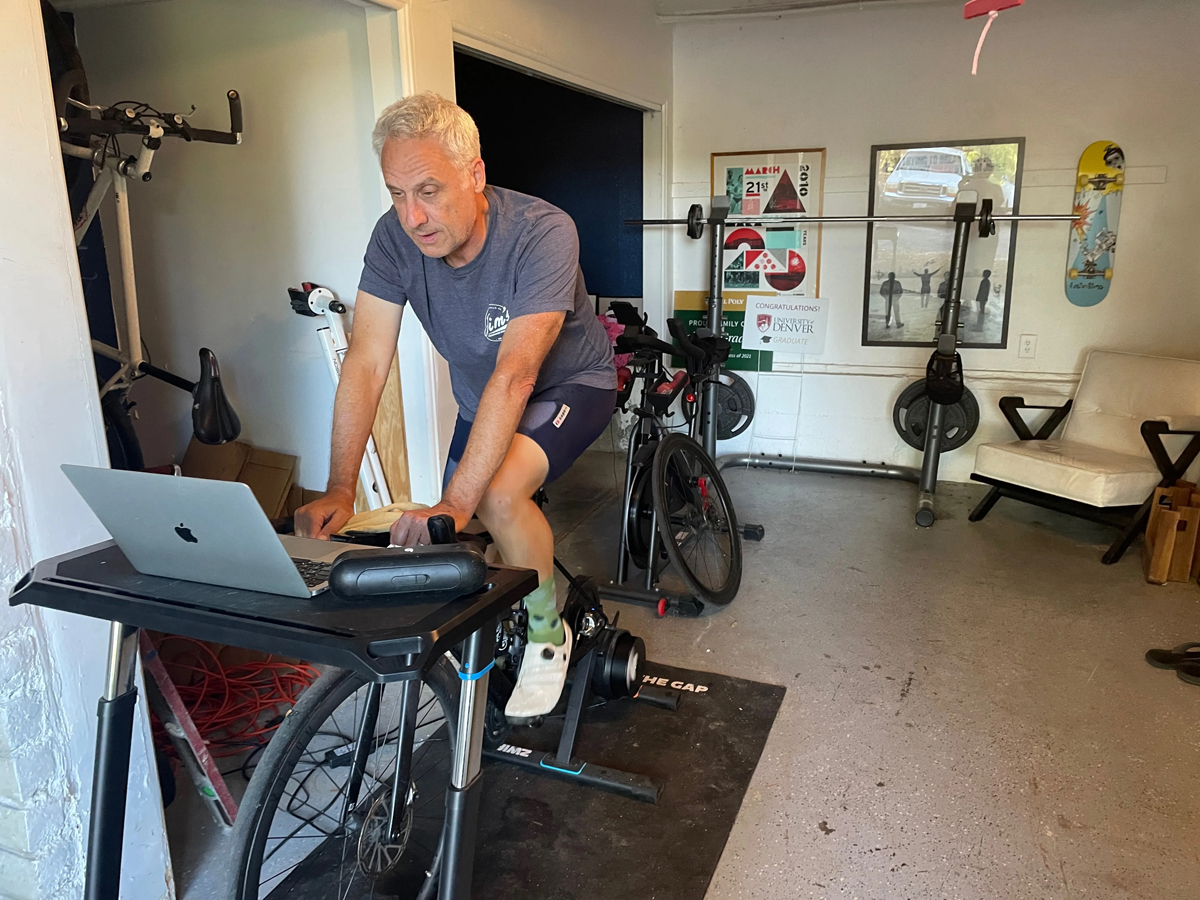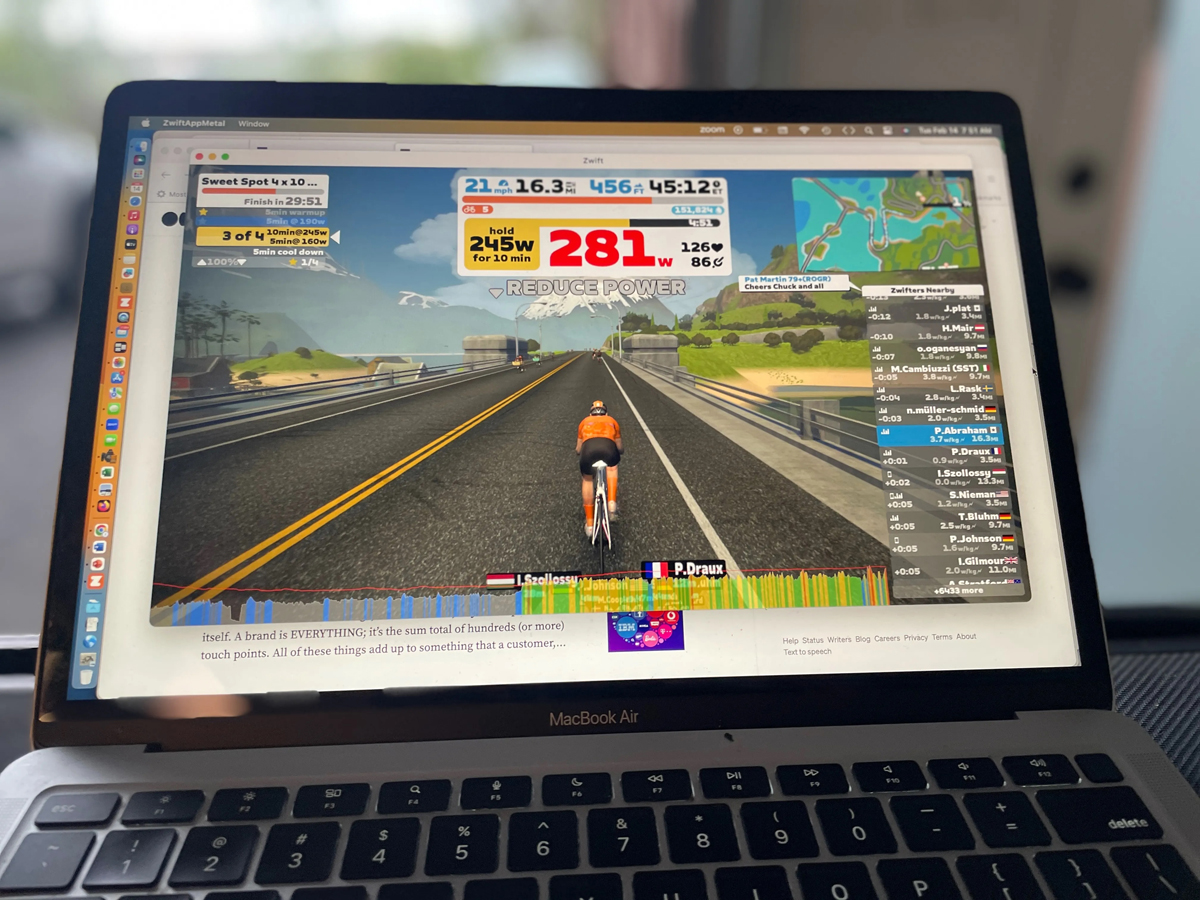By Peter Abraham — Early last year, my friend Steve Beckett, CMO at Zwift, gifted me their Hub trainer to try out. I had not used Zwift or any other virtual training platform at all. I of course had heard of Zwift, and I often saw the virtual workouts of my friends on Strava. But I had not done any stationary training for over 15 years. In those days as a masters bike racer I had a wind trainer that was not connected digitally at all. But the world has changed and virtual training is an entire category of cycling that did not even exist last time I rode indoors.

Given the unusually rainy winter we had in 2023, it was a good time to get started with virtual training. As someone who was totally committed to riding outdoors all the time, it took me a few sessions to acclimatize to riding indoors and online. But I soon became a convert. There are many online platforms, like Rouvy, MyWhoosh and TrainerRoad. But I have focused on Zwift, because that’s where most of my friends are. I still love riding outdoors, although Zwifting is now a key part of my training. There are all kinds of nuances and sophisticated technical features on the Zwift platform. I won’t get too far into those details. YouTube is full of videos about all of that stuff. Generally, here’s why I love riding virtually:
- Time efficiency: When you ride on a trainer, there is no coasting downhill, there are no stop signs, no waiting for red lights, none of that. You are pedaling for 100% of the workout. That means an hour ride on Zwift is comparable to 1.5 or more hours outdoors. And there’s less gearing up and gearing down for a ride. So you get the same amount of fitness in about half the time when riding indoors. Sometimes I just run down to the garage and squeeze in 30 minutes on Zwift. That counts as a workout.
- Avoiding the weather and the dark: it feels like a luxury to ride without worrying about heat (very much an issue where I live in LA), rain or pre-dawn or evening darkness. Compared with riding outdoors, your rides are not at all limited by any of these things. This opens up a bunch of new times to ride: mid-day in the summer, nights and super early mornings.
- Injury recovery: I recently went through a challenging 6-month period where I had a MTB crash that resulted in a concussion, and then a herniated disc in my neck. Both of these injuries meant that I could not safely ride outdoors for weeks at a time while I was recovering. Being able to jump on Zwift was crucial for me — I was still able to work out but in a way that was safe. In both cases I could also start with very easy zone 1–2 rides that are hard to do outdoors in the hills around my house.
- Motivation: When you’re in a Zwift ride, there are generally lots of other Zwifters, sometimes hundreds, there as well. And with each person’s nationality flag displayed, you can see that you’re riding with people from all over Europe, Asia, Australia and even further afield. If it’s a race (there are workouts, events, races, group rides or you can just ride on your own) you really do have to push to keep up with a fast group. I find that I often ride harder than if I was just trying to do, say, intervals by myself. There is real benefit to being pushed outside of your comfort zone when you want a really hard workout. And there are all kinds of interesting events tied into different Zwift virtual worlds (Watopia, London, Yorkshire, France, etc). I’ve done a bunch of Tour de France climbs, group rides with professional teams, and I’ve even by chance virtually run into my friend Eric Min, the co-founder and CEO of Zwift, during a ride.
- Safety: As important as riding outdoors is to me, being on the road with cars does pose very real dangers. Sometimes it’s nice to not worry about that, zone out, listen to some music or a podcast and get a stress free workout in. This is an indoor cycling benefit that you just can’t dismiss.

I recommend adding indoor riding to your training repertoire if you have not already. The only negative of indoor training for me is having to take my bike on and off the trainer in the garage when I want to ride outdoors. The switch only takes a minute or so, but I wish I had a dedicated indoor training set up. Were I starting from scratch right now, I might get this new Zwift Ride stationary bike. This slick, purpose-built bike would just live in my pain cave and be ready to ride at a moment’s notice.







![Cycling and Achilles Tendon Pain The muscles of the anterior compartment of the lower leg are generally responsible for dorsiflexion, and the muscles of the posterior compartment of the lower leg are generally responsible for plantar flexion. The lateral and medial muscles in both compartments invert, evert, and rotate the foot. By OpenStax College (https://cnx.org/contents/FPtK1zmh@8.108:y9_gDy74@5) [CC BY 3.0 (https://creativecommons.org/licenses/by/3.0)], via Wikimedia Commons Download for free at http://cnx.org/contents/14fb4ad7-39a1-4eee-ab6e-3ef2482e3e22@8.108](https://www.cyclingwest.com/cms/wp-content/uploads/2014/05/1123_Muscles_of_the_Leg_that_Move_the_Foot_and_Toes_b-100x70.png)
